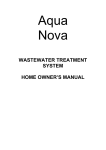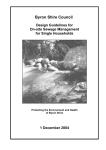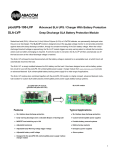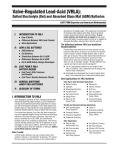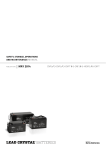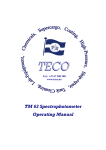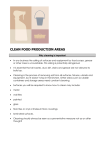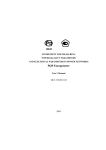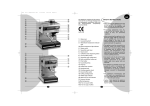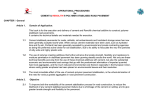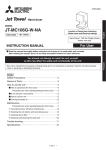Download Owners manual
Transcript
WASTEWATER TREATMENT SYSTEM HOME OWNER’S MANUAL Introduction Congratulations on the selection of the Aqua-nova Aerated Wastewater Treatment System. The system that you have purchased uses similar processes and technologies of the sewage treatment plants used in large townships and cities, and are suitable for use in most domestic and commercial applications. Correctly installed and maintained the Aqua-nova system can efficiently treat all of the waste water from your toilet, kitchen and bathroom so that it can be safely re-used in garden irrigation. The quality of the final effluent meets the requirements established by State Governments around Australia. The Aqua-nova has passed a stringent testing program which was undertaken over a period of six months. The Aqua-nova is designed to minimise the operational costs to the owner drawing a minimum amount of electrical energy. However, like all of your other assets, the Aquanova requires a certain amount of operating maintenance and most local authorities require these units to be serviced by persons accredited to perform this duty. Your role as the owner is to ensure that routine maintenance on your Aqua-nova occurs, and to know the limitation of the system to ensure its effective operation. We recommend that owners take the time to understand their new asset and perform a weekly inspection of the unit. This inspection should simply include checking for any odours and sounds produced by the Aqua-nova. Please take the time to read this manual carefully and completely. This will aid in avoiding needless service calls, protecting your investment and safeguarding the health of your family. 2 AQUA NOVA OWNER MANUAL Rev 2 (03.06) The Aqua-nova Treatment System The Aqua-nova Treatment System is a fully integrated and completely automatic treatment process which is designed to treat up to 2000L of household water per day. The system relies on physical, biological and chemical treatment processes to produce high quality water. The efficiency of these processes is heavily impacted on by the volume of water entering the system and the quality of that water. The Aqua-nova is made up of four parts : • • • • Primary Sedimentation / Anaerobic Digestion Aerobic Digestion Final Clarification Disinfection / Pump Out Well Figure 1 System Layout Air Lift / Recirculation Primary Sedimentation Anaerobic Digestion Aerobic Digestion Irrigation Disinfection Final Clarification What must be understood by the owner is that approximately 90% of the treatment plant requires the growth of bacteria. Disposing of poisons, chemicals and cleaners can kill the bacteria that the system needs to operate effectively and can result in water of poor quality being produced. We therefore urge all owners to limit the amount of disinfectants and bactericides that they use in cleaning, and to adopt practical measures to minimise their general use. If these chemicals must be used the owner should try to dilute the material prior to or during disposal. 3 AQUA NOVA OWNER MANUAL Rev 2 (03.06) Primary Sedimentation / Anaerobic Digestion Primary Sedimentation and Anaerobic Digestion takes place in the first tank where we allow for the separation of most of the solids and oils from the water. Each anaerobic tank is designed with a baffled inlet and outlet to ensure short circuiting does not occur to maximise the efficiency of the process. The baffled outlet acts as a dam to limit the release of floated material into the aerobic tank. To improve the efficiency of this process we allow water to remain in the tank for the longest practical time. Figure 2 Separation of Contaminants Inlet Outlet There is no oxygen in the primary tank. This, combined with a large amount of settled organic material, allows anaerobic digestion to occur. This is a very slow process and principally occurs at the bottom of the tank. Complete digestion is achieved through the growth of two types of bacteria. One type of bacteria breaks down the larger organic material to produce organic acids. The other type of bacteria consumes these organic acids to produce methane and carbon dioxide. These two compounds are released as gases, however as they float to the top of the tank, solids attached to the bubbles are carried to the surface. These solids mix with the separated oils to produce a floating scum or crust. Oils + Suspended Solids Settled Solids + Floating Scum +CO2 +CH4 It is important that owners of the Aqua-nova understand that problems will occur if a suitable environment in the primary tank is not maintained. While this is easily achieved by keeping the effluent in the tank at near neutral (pH = 7.0) it can be very easily disrupted. Most problems occur because the pH is allowed to drop below 6.5. 4 AQUA NOVA OWNER MANUAL Rev 2 (03.06) A decrease in pH can be caused by the natural generation of organic acids. This usually occurs at the startup of a new system and, if it is not corrected, can result in very acidic conditions. This is because the metabolic activity of the second type of bacteria, which consume the organic acids, decreases in low pH environments. This environment can also be produced when acids are disposed of down the sink. An acidic environment in the primary tank typically results in odour problems. These odours are frequently caused by sulfur based compounds, the most common of these being hydrogen sulfide. Na2S +2H+ NaHS + Na+ +H+ H2S( ) + 2Na+ In an environment where the pH is greater than 7.0, Hydrogen Sulfide (H2S) is not present. With the addition of acid (H+) any Sulfide ions will combine with the acid which will allow the odorous gas to be produced. Our design allows for most of Hydrogen Sulfide to be oxidized by the small amount of oxygen in the treated water which is recirculated from the clarifier. H2S + 2O2 2H2SO4 Unfortunately in extreme conditions this control measure is ineffective, resulting in the release of odours which are typically detected by neighbours before the owner. Odours can also result from having a pH that is too high which is sometimes caused by the use of very caustic washing detergents. This is due to the volatilization of ammonia. NH4+ + OH- NH3( ) + H2O It is evident that owners try to maintain the pH in the primary tank between 6.5 – 7.5. Another problem associated with the primary tank is the influx of massive amounts of water from operating too many appliances that discharge water to the system or from the emptying of a spa bath. Large influxes of water can mix the settled solids back into the water and result in solids being transferred into the Aerobic Tank. It is always best practice to operate only one appliance at a time and allow for the slow release of water from a spa or large bath. 5 AQUA NOVA OWNER MANUAL Rev 2 (03.06) Aerobic Tank The Aerobic Tank, which is fitted with an aerator and biological media, is where most of the organic material in the wastewater is removed. The aerator provides a constant stream of air to the tank. This ensures that the water in this tank is oxygenated and allows for the growth of aerobic bacteria. While this type of bacteria can live suspended in the water, most of the bacteria will bind to the media to form a biofilm. This process can be commonly seen in shallow creek beds where bacteria can be seen growing on rocks. In this environment aerobic bacteria will consume soluble carbohydrates at a relatively constant rate. Suspended solids are also absorbed into the biofilm. Enzymes are excreted by bacteria allowing for the digestion of biodegradable material. This process is very efficient when compared with anaerobic digestion and the bacteria can multiply very quickly. Excess bacteria are constantly being shed from the biofilm through erosion and sloughing processes. These bacteria will remain alive in suspension until they are either reabsorbed into the biofilm or washed into the clarifier. One of the main benefits associated with this system is that the bacteria population are resistant to changes in flow and the availability of food. High flow conditions can “wash-out” all the bacteria in other systems while a decrease if the level of carbohydrates in the aeration tank can allow for the growth of problematic bacteria Figure 3 Biofilm Aerobic Digestion Process Biofilm Media Carbohydrates Oxygen Carbon Dioxide Water Very few problems are associated with the aeration tank as long as the aerator remains operational. Remember, no air, no oxygen, no aerobic activity!! If the aerator fails immediately call your service agent. 6 AQUA NOVA OWNER MANUAL Rev 2 (03.06) Final Clarification The final clarifier is a stilling zone that allows remaining solids to be removed from the treated water. Solids settle to the bottom of the tank where they are pumped back to the primary tank to be digested. This always allows a small volume of water to continuous cycle through the treatment system. This allows for a dilution of incoming waste water and provides a small amount of oxygen for the oxidation of sulfide compounds. The efficiency of the clarification process is maintained by maximizing the retention time in the clarifier. Again the influx of large amounts of water will reduce the time allowed for solids to settle and cause currents in the clarifier that will inhibit the settling process. Disinfection Disinfection is the most critical step in the treatment process. Our system allows for the automatic and ongoing disinfection of the treated water. For disinfection to work effectively water must remain in this chamber for the longest possible time for the chemicals to work. This is called ‘contact time’. If the Aqua-nova is regularly serviced, the only problem that can occur is through hydraulic overloading. Shock hydraulic loads will reduce this ‘contact time’ and reduce bactericidal effect of the chemical. Further to this, hydraulic surges can reduce the amount of solids that can be settled in the final clarifier and allow organic material to flow into the disinfection chamber. This material can react with the disinfectant, reducing the amount of disinfectant available for killing harmful bacteria. Irrigation Treated water is irrigated as per the development application. This area has been calculated using standard methods and approved by the local authority. This area must not be altered. DO NOT – • • • • • Alter this area. Change the area so that treated wastewater may enter a dam or watercourse, Change the area so that treated wastewater my flow onto paths or vehicle traffic areas. Grow fruit, vegetables, crops or vegetation used for food stuffs in this area, Use treated water for drinking or for any purpose of bodily contact 7 AQUA NOVA OWNER MANUAL Rev 2 (03.06) Owners Responsibilities The owner is responsible for ensuring that the system continues to satisfy the requirements of the local authority. The owner must ensure that the correct operating conditions are followed, producing a treated effluent that meets the criteria for water quality. Once installed the system must never be turned off. When the system is installed an effluent irrigation system has been installed to safely disperse the treated water. This irrigation system must not be moved, extended or altered in any way without written authority from the local authority. Hydraulic Surges As stated in previous sections, all of the treatment processes will be affected if large amounts of water are disposed of at one time. This can include – • • • • Lower the retention time of the waste water in all treatment processes, Resuspension of solids in the primary tank, Poor settling of solids in the final clarifier, Poor disinfection. The Aqua-nova has been tested under operating conditions specified in Australian Standards that incorporate surges of more than 800L over a five hour time frame. Options for managing Hydraulic Flows and conserving water – • • • • • • Install water saving fixtures (shower roses, tap nozzles, etc) Have short showers, Use one water appliance (washing machine, dishwasher, etc) at a time Spread laundry washing throughout the week, Place a sponge in the plug hole when emptying a bath or spa. NEVER attach a stormwater drain to the system. Organic Overload The Aqua-nova is designed to treat a specific amount of organic material. An influx of organic material into the primary tank will generate higher concentrations of odorous gases and increase the buildup of solids in this tank. This will result in an increase in operational costs as the system will require more frequent pump-outs. If the system is overloaded with organic material there will not be sufficient bacteria or oxygen to allow the waste to be digested. This will result in an increase in BOD5 in the treated water and reduce the efficiency of the disinfection process. 8 AQUA NOVA OWNER MANUAL Rev 2 (03.06) Options for managing organic loads – • • • • • Scraps and peelings produced in the preparation of food should not be disposed of down the sink, Remove food scraps from plates and utensils prior to washing, Dispose of waste food in the rubbish bin or compost. While it is preferable that a food disposal units is not used, the owner should try to minimize their everyday operation, Do not dispose of fats, oils, greases or mineral based greases down the sink. Chemicals Many solvents, chemicals and other liquid products that used in households can kill bacteria. In fact many of these chemicals, including cleaners, anti-mould agents and disinfectants, are designed for this purpose. If they are allowed to enter an Aqua-nova they will kill the bacteria used in the treatment process. Remember that our system uses bacteria to biodegrade organic material, all chemicals that are non-biodegradable waste can pass through the system unaltered and be irrigated on your property. There is a simple rule that must be adopted for chemical – DO NOT DISPOSE ANY MEDICINES, CHEMICALS, SOLVENTS OR PAINTS DOWN THE DRAIN. Some chemicals are extremely toxic to bacteria at low concentrations. Failure to adhere to this rule may result in the death of all bacteria in a system. To rectify this failure can require the complete pump-out of both tanks. Options for managing cleaning products – • • • • • Natural cleaning products should be favoured in the owner’s house. Disinfectants or similar products should be used effectively but sparingly, Buckets of water used to disinfect floors and surfaces should be safely stored overnight to reduce the impact of the chemicals, The owner must not use of strong disinfecting agents, bleaches and dyes in the laundry, kitchen or bathroom, The use of hair dyes and bleaches should be limited. 9 AQUA NOVA OWNER MANUAL Rev 2 (03.06) Do’s and Don’t for trouble free Operation The following are some practical hints to help keep your Aqua-nova system working in top condition. As noted earlier, the Aqua-nova system relies on two types of bacterial action for it to function correctly. Therefore any products that are designed to reduce bacterial activity such as antiseptics, disinfectants, or bleaches should be avoided. Otherwise the system could become foul smelling and not work efficiently due to the killing off of bacteria. In the Laundry DO Use biodegradable detergents and softeners which are sodium and phosphorous free (i.e. less than 0.05% total phosphorus by weight). Try and use a smaller amount of detergent, to prevent excessive foaming (or add washing soda). Spread your wash load over several days if possible, to avoid hydraulic overloads. Wash the dog in the yard and not in the laundry tub. Pre-soak soiled nappies in 45g of Bicarbonate of Soda dissolved in warm water and wash in hot soapy water. Use washing soda as an effective water and fabric softener. DON’T Use bleaches, antibacterial, or antiseptic solutions. If you need to use these products, place in a bucket or bowl and dispose of the water in the yard. In the Kitchen DO Use dishwasher powder with alkaline as the alkalinity is important in the removal of ammonia. So check the label for this and phosphorus content. Use biodegradable detergents in the sink. Use washing soda in hot water to unblock drains. DON’T Minimise the use of a garbage grinder, as the solids will overload the system. 10 AQUA NOVA OWNER MANUAL Rev 2 (03.06) In the Toilet and Bathroom DO Use crème cleansers or detergents which are sodium and phosphorus free. Try using liquid soaps for hands and bodies as this helps prevent build up on the hard surfaces thus makes them easier to keep clean. Try cleaning the toilet by regular brushing. If heavily stained try a bowl of hot suds and allow to stand before brushing. DON’T Use toilet cleaners or Blue Loo because they are anti-bacterial and will affect the system. Clean paint brushes in the system. Use or pour kerosene into the system. Allow foreign matter such as sanitary napkins, cotton balls, cigarette butts, disposable nappies, or nappy liners to enter the system as they causes blockages and add to solid waste. APPLY THE GOLDEN RULE – IF IN DOUBT, LEAVE IT OUT. Smells from sink or basin plugholes can be eliminated by using a handful of washing soda in a cupful of hot water, emptied into the plug hole last thing at night. If you have any queries regarding the use of certain products in your system, please do not hesitate to call your Agent or nearest Aqua-nova office. Service Contracts The Aqua-nova service contract for new installations automatically come into effect when the Everhard approved agent first commission your new Aqua-nova system. The first twelve months of essential materials and labour, including calls for emergency service of the system or equipment failure is free of charge. • The Everhard Aqua-nova introductory offer includes the initial commissioning, and three services, at three-month intervals, at which time samples of the treated effluent are tested for clarity, and the presence of sanitising material. • Each service includes the purging of settled solids from the Treatment Tank Sediment Chamber into the Primary Tank, the replenishment of the sanitising chemicals, testing and inspection of the electrical / control system, the aerator and irrigation feed pumps. • Reports of the work done, and any test results, are supplied to the owner. Copies are forwarded to the local authority. • Local authorities may also require samples of treated effluent to be tested at any time at the Owner’s expense. These tests are not included in the regular service contract. • Service calls, which are the result of household practices likely to cause failures, are not included in this offer. 11 AQUA NOVA OWNER MANUAL Rev 2 (03.06) Service Contracts Renewal • • After the first year’s operation it is essential to enter into a regular service contract. Only personnel trained and competent to service these advanced AWTS installations should be permitted to carry out any work on the Treatment system. Owners of Aqua-nova systems are strongly urged to select an agent appointed and trained by Everhard Industries Pty Ltd and approved by the local authority. In many cases, local authorities insist that a maintenance contract exist before approval to operate an AWTS installation is granted. Local authorities also insist that contracts for existing installations are in force. Service agents are required to notify local councils about terminated contracts Emergencies Everhard approved service agent’s offer a 24-hour emergency call-out service for speedy correction of system failures. It is strongly recommended that the owner regularly check the AWTS installation for indication that’s a problem may exist. • • • • • • All Aqua-nova AWTS installations are equipped with a audible alarm that are fitted within your house. This will switch on if either the aerator supply pump or the integrated pump feeding the irrigation system fails. The audible alarm will NOT be activated if there is a general power failure, or if the supply to the system is interrupted. Following any general power failure, check that the circuit breaker is re-set. Should either of the pumps stop running, check power to the AWTS installation. If the circuit breaker has not tripped, and the pump is plugged in and switched on but does not run, call for a service agent. The Aqua-nova installation is protected by a dedicated Circuit Breaker fitted in the residential main switchboard by a licensed electrician when the Aqua-nova is installed. This will be tripped if an electrical fault occurs, and power to the aeration supply pump and irrigation supply pump will be shut off. If this happens, re-set the circuit breaker. Should the circuit breaker continue to trip, call your agent. If a continuous strong odour of sewerage or chlorine appears around the tanks or the irrigation network, call for service. If wet patches appear and remain evident near fixed irrigation pipes or around tanks, or if the sprinklers appear to be receiving water at reduced pressure, check for kinked or damaged connections and piping, and blocked sprinkler jets. If the pressure is still low, there may be a pump problem. Call a service agent. 12 AQUA NOVA OWNER MANUAL Rev 2 (03.06) Unnecessary service calls can be minimised by the owner first making some simple checks and observations that may indicate to the Agent what the problem may be. In the event of a system fault or alarm; • • • • Check the circuit breaker and ensure there is power available to the system. If the breaker has tripped reset it to the on position. If the circuit breaker continues to trip out, call your Agent. Check inside the Tank Top Control Box to ensure both plugs are seated in their power outlets, and that the air pump is running. Ensure that irrigation hoses are not kinked or crushed. Listen for bubbling sounds in the treatment tank. If you do need to call for a service agent, minimise water usage as much as possible until the fault is corrected. Call for a plumber if any toilet or other fixtures fail to drain freely. Such problems are usually due to pipe blockages rather than AWTS system failure. The plumber will advise you if there is a problem with the system. General Notes Both concrete and polymer Aqua-nova tanks will be installed so that the access and inspection covers are exposed. The polymer tank’s sloping top cover may be lightly covered over with mulch or bark, but access and inspection covers on tanks MUST NOT be buried. Access and inspection covers and the control box MUST ALWAYS be freely accessible. All Everhard Wastewater Tanks are tested to support the 5kN (500kg) top load, and likely side loading, required by the National Standard AS/NZS1546.1:1998 for small septic tanks. This is NOT an indication that tanks can be expected to safely withstand continually applied loads. No regular pedestrian traffic over tanks should be permitted. No vehicle traffic should be permitted within 600mm of any tank unless approved load carrying hardstand traffic is installed. In some cases, where the local authority permits, the irrigation network may feature moveable sprinklers. These may be relocated from time to time to allow more even distribution of re-claiming water for garden use. • • • • DO NOT re-locate fixed sprinkler or sub-surface irrigation outlets without the express approval of the local authority DO NOT establish irrigation outlets where the treated effluent may enter watercourses or dams. DO NOT allow treated wastewater to come into direct contact with crops or other vegetation used for foodstuffs. DO NOT use treated wastewater for drinking or for bodily contact. 13 AQUA NOVA OWNER MANUAL Rev 2 (03.06) • DO NOT install irrigation outlets in pedestrian or vehicular traffic areas. WARRANTIES Your Aqua-nova system is fully guaranteed. For strength and durability only superior products are used. You system is fully warranted as follows. Tanks Electrical Components 15 years 2 years Keep this manual and all service reports about your Aqua-nova system in a safe place. They should be handed to the homeowner if you decide to move. FOR ALL SERVICE CALLS, CONTACT YOUR SERVICE AGENT…………………………….. Address…………………………………………………………………………………… …………………….. Phone………………… Fax…………………. BE SURE TO QUOTE YOUR CONTRACT NUMBER ……………………….. The EVERHARD WARRANTY starts from the Commissioning date …/…/…... For all Warranty Claims, contact your Service Agent first to arrange for a Claim to be processed. Alternatively, write to EVERHARD Head Office, to the attention of the Customer Service Manager. 14 AQUA NOVA OWNER MANUAL Rev 2 (03.06)














